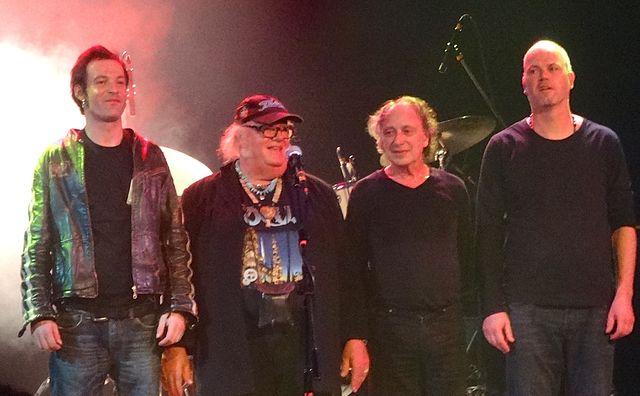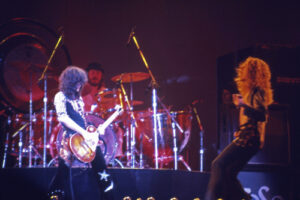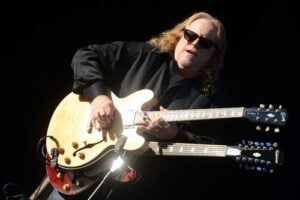
Feature Photo: bahadir aydin / Shutterstock.com
# 10 – In My Darkest Hour – Megadeth
Megadeth recorded “In My Darkest Hour” for their third studio album, So Far, So Good… So What!, released on January 19, 1988. The song was produced by Paul Lani and recorded at Music Grinder Studios in Los Angeles. The lineup featured Dave Mustaine on vocals and rhythm guitar, Jeff Young on lead guitar, David Ellefson on bass, and Chuck Behler on drums. “In My Darkest Hour” stood out on the album as one of the most emotionally charged compositions, blending the band’s signature thrash sound with deeply personal lyricism. It was written in response to the death of Metallica bassist Cliff Burton, though the lyrics reflect Mustaine’s personal struggles with isolation and betrayal.
Lyrically, the song plunges into despair and emotional devastation, making it an apt inclusion in a list of the darkest rock songs. Mustaine’s lyrics convey abandonment, loneliness, and the bitter realization of a one-sided relationship. Lines like “Through the darkest hour, your grace did not shine on me” and “Did you ever think that I needed love?” speak to feelings of rejection and the absence of support during times of need. The song’s most harrowing moment comes with the lines “Things will be better when I’m dead and gone,” reflecting a suicidal mindset shaped by overwhelming pain. The nihilistic acceptance of death as a release, reinforced by “But I got to die first, please, God, send me on my way,” cements the song’s bleak outlook, making it one of Megadeth’s most emotionally raw compositions.
Read More: James LoMenzo of Megadeth: 10 Albums That Changed My Life
# 9 – Riders On The Storm – The Doors
A ghostly presence lingers over L.A. Woman, and nowhere is that more apparent than in “Riders on the Storm.” Recorded in late 1970 at The Doors Workshop in Los Angeles, this song became the band’s final recording with Jim Morrison before his death in July 1971. Produced by Bruce Botnick and The Doors, the track featured Morrison’s spectral vocals, Ray Manzarek’s ethereal electric piano, Robby Krieger’s haunting guitar lines, and John Densmore’s jazz-inflected drumming. The addition of Jerry Scheff, best known for his work with Elvis Presley, on bass gave the song an underlying pulse, creating an atmosphere that was both hypnotic and unsettling. Released as a single, it reached No. 14 on the Billboard Hot 100, but its legacy extends far beyond chart success, embedding itself as one of the darkest and most enigmatic songs in rock history.
Read More: The Doors Most Underrated Songs
# 8 – What’s He Building In There – Tom Waits
Tom Waits transformed paranoia into performance art with “What’s He Building in There?”, a track from his 1999 album Mule Variations. Recorded at Prairie Sun Recording Studios in Cotati, California, the song was produced by Waits alongside Kathleen Brennan. Unlike traditional compositions, “What’s He Building in There?” abandoned melody in favor of an unsettling spoken-word delivery, backed by sparse, eerie instrumentation. The recording featured Waits’ signature guttural narration, accompanied by distant, metallic clanking, ambient industrial noises, and unsettling creaks that intensified its air of mystery. This unconventional arrangement, devoid of traditional song structure, made it one of the most disturbing entries in Waits’ catalog.
Read More: Tom Waits’ Best Song From Each Of His Studio Albums
# 7 – Nebraska – Bruce Springsteen
A stark, unflinching portrait of senseless violence, “Nebraska” opened Bruce Springsteen’s 1982 album of the same name with chilling simplicity. Recorded as a solo acoustic demo on January 3, 1982, at Springsteen’s home in Colts Neck, New Jersey, the track was initially intended as a rough outline for a full-band arrangement with the E Street Band. However, its bleak intimacy was so powerful that Springsteen opted to release it as-is, preserving the raw, haunting quality of the original tape. The album, produced by Springsteen alongside Jon Landau, Chuck Plotkin, and Steve Van Zandt, was a radical departure from the grandiosity of The River, stripping everything down to a man, his guitar, and the ghosts of his narratives.
Read More: Complete List Of Bruce Springsteen Songs From A to Z
# 6 – Ticking – Elton John
Elton John and Bernie Taupin crafted a chilling narrative of alienation and unchecked violence with “Ticking,” the final track on Caribou, released on June 28, 1974. Recorded at Caribou Ranch in Colorado and produced by Gus Dudgeon, the song abandoned the grandiose arrangements typical of John’s mid-1970s output, relying solely on his vocals and a melancholic piano to tell its devastating story. Unlike the anthemic hits that defined his commercial peak, “Ticking” was never released as a single, yet its harrowing subject matter and stark presentation have made it one of the most haunting pieces in his catalog.
Read More: Complete List Of Elton John Songs From A to Z
# 5 – Mr. Crowley – Ozzy Osbourne
Dark mysticism and theatrical grandeur collided in “Mr. Crowley,” one of Ozzy Osbourne’s most ominous compositions. Recorded in 1980 at Ridge Farm Studio in England, the track appeared on his debut solo album, Blizzard of Ozz. Produced by Osbourne, Randy Rhoads, Bob Daisley, and Lee Kerslake alongside engineer Max Norman, the song blended heavy metal power with gothic atmosphere, solidifying Osbourne’s post-Black Sabbath identity. Featuring Rhoads on guitar, Daisley on bass, Kerslake on drums, and Don Airey on keyboards, “Mr. Crowley” showcased an unrelenting blend of eerie organ swells and neoclassical guitar work that elevated its sinister aura.
Read More: Top 10 Ozzy Osbourne Songs
# 4 – Fade To Black – Metallica
Not much needs to be written about this one. It’s Metallica in one of their darkest moments on vinyl. Released on the band’s sensational Ride The Lightning album.
Read More: Complete List Of Metallica Songs From A to Z
# 3 – Cold Ethyl – Alice Cooper
Few artists have blurred the line between horror and rock ‘n’ roll as effectively as Alice Cooper, and “Cold Ethyl” remains one of his most unsettling compositions. The song was recorded for Welcome to My Nightmare, Cooper’s first solo album following the dissolution of the original Alice Cooper band, released on March 11, 1975. Produced by Bob Ezrin and recorded at Soundstage Studios in Toronto, the track featured a lineup of accomplished session musicians, including Dick Wagner and Steve Hunter on guitars, Tony Levin on bass, Whitey Glan on drums, and Jozef Chirowski on keyboards. While Welcome to My Nightmare was a concept album centered around the character of Steven and his descent into madness, “Cold Ethyl” stood out as one of its most macabre moments, injecting grim humor into an otherwise terrifying premise.
Read More: 10 Best Alice Cooper Songs To Turn Up To Eleven
# 2 – Sympathy For The Devil – The Rolling Stones
The Rolling Stones introduced one of the most controversial narrators in rock history with “Sympathy for the Devil,” recorded for their 1968 album Beggars Banquet. Tracked at Olympic Studios in London and produced by Jimmy Miller, the song featured Mick Jagger on vocals, Keith Richards on bass and electric guitar, Charlie Watts on drums, Bill Wyman on maracas, and Nicky Hopkins on piano. The recording process evolved dramatically, beginning as a folk-influenced piece before transforming into a sinister samba, driven by pulsating percussion and Richards’ hypnotic rhythm work. Released at a time of political upheaval and cultural rebellion, the track’s dark subject matter and provocative themes cemented its place as one of the band’s most infamous compositions.
Read More: The Rolling Stones 24 Tour Rocks MetLife Stadium Review 5-23-24
# 1 – Black Sabbath – Black Sabbath
Not many songs in rock history have conjured a sense of pure dread as effectively as “Black Sabbath,” the opening track from Black Sabbath’s 1970 debut album of the same name. Recorded at Regent Sound Studios in London in October 1969 and produced by Rodger Bain, the song introduced the world to the unrelenting darkness of heavy metal. The lineup, including the late Ozzy Osbourne on vocals, Tony Iommi on guitar, Geezer Butler on bass, and Bill Ward on drums, crafted an atmosphere so foreboding that it permanently altered the trajectory of rock music. The use of the tritone, historically dubbed “Diabolus in Musica” for its unsettling sound, reinforced the track’s sinister aura, making it one of the most menacing compositions ever put to tape.
“Black Sabbath” reads like a waking nightmare. Osbourne’s wailing delivery of “What is this that stands before me? Figure in black which points at me”
Read More: An Interview With Geezer Butler Of Black Sabbath
Check out similar articles on ClassicRockHistory.com Just click on any of the links below……
10 Best Rock Songs In Marvel Movies
Top 10 Classic Rock Songs About Time
Top 10 Songs About Hope And Inspiration
Top 10 Classic Rock Songs About Fire
25 Best Classic Rock Comeback Albums
New Keith Richards Album Will Be Called Crosseyed Heart
Read More: Artists’ Interviews Directory At ClassicRockHistory.com
Read More: Classic Rock Bands List And Directory
Updated July 23, 2025



































